indicator BMW X1 2014 E84 Owner's Manual
[x] Cancel search | Manufacturer: BMW, Model Year: 2014, Model line: X1, Model: BMW X1 2014 E84Pages: 297, PDF Size: 7 MB
Page 18 of 297
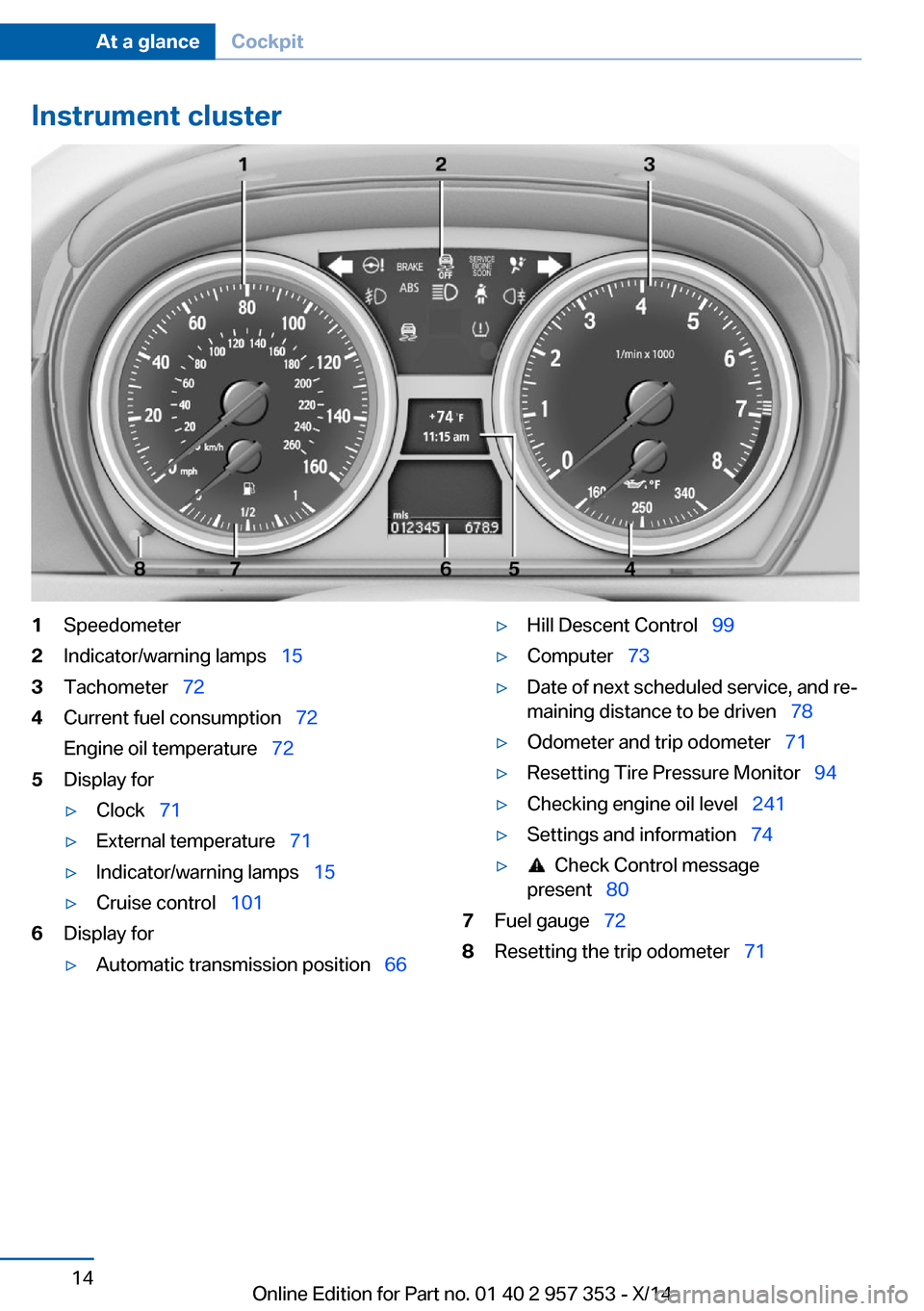
Instrument cluster1Speedometer2Indicator/warning lampsтАВтАЕ153TachometerтАВтАЕ724Current fuel consumptionтАВтАЕ 72
Engine oil temperatureтАВтАЕ 725Display forтЦ╖ClockтАВтАЕ71тЦ╖External temperatureтАВтАЕ 71тЦ╖Indicator/warning lampsтАВтАЕ 15тЦ╖Cruise controlтАВтАЕ1016Display forтЦ╖Automatic transmission positionтАВтАЕ 66тЦ╖Hill Descent ControlтАВтАЕ99тЦ╖ComputerтАВтАЕ73тЦ╖Date of next scheduled service, and reтАР
maining distance to be drivenтАВтАЕ 78тЦ╖Odometer and trip odometerтАВтАЕ71тЦ╖Resetting Tire Pressure MonitorтАВтАЕ 94тЦ╖Checking engine oil levelтАВтАЕ241тЦ╖Settings and informationтАВтАЕ74тЦ╖ Check Control message
presentтАВтАЕ 807Fuel gaugeтАВтАЕ 728Resetting the trip odometerтАВтАЕ 71Seite 14At a glanceCockpit14
Online Edition for Part no. 01 40 2 957 353 - X/14
Page 19 of 297
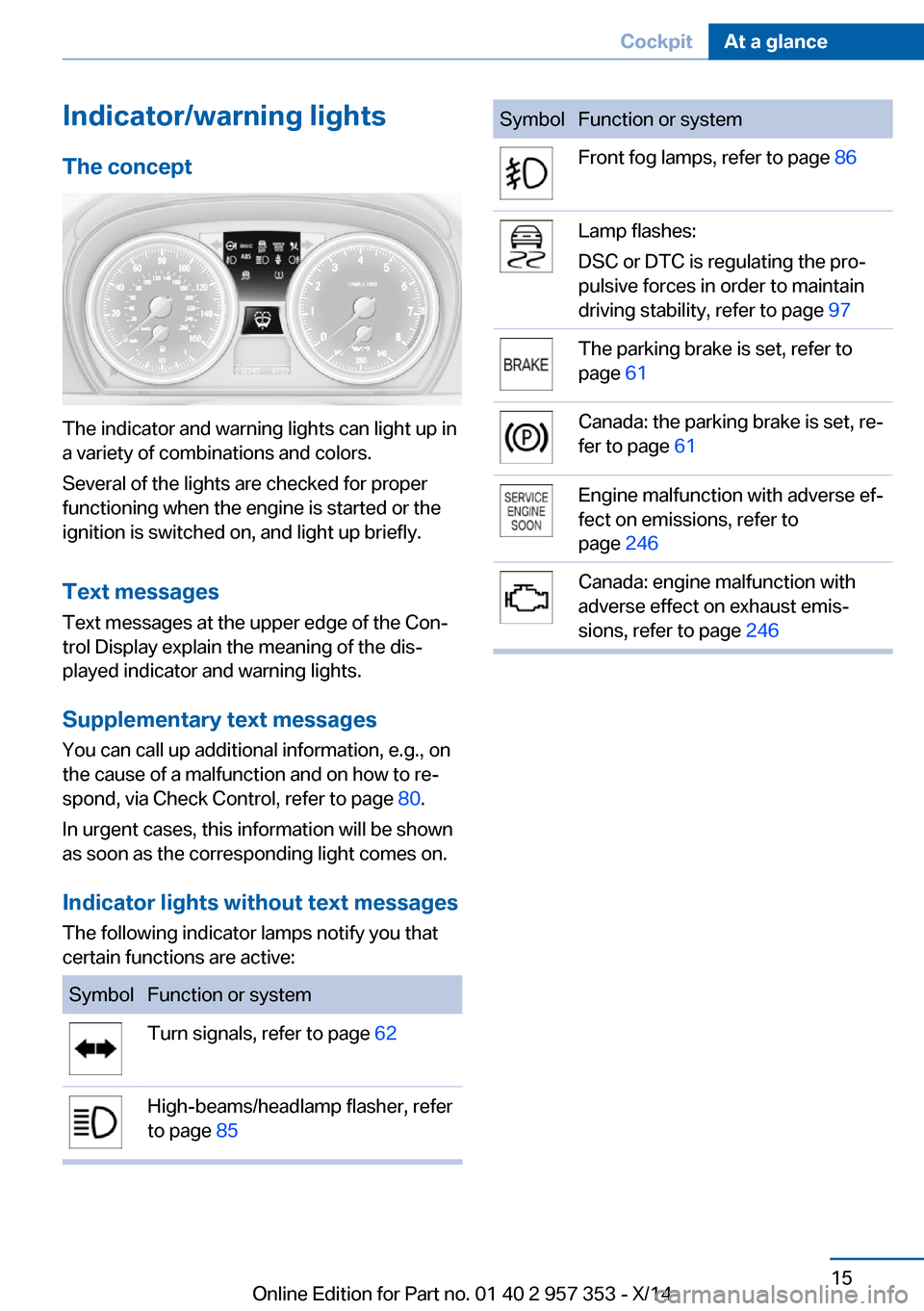
Indicator/warning lightsThe concept
The indicator and warning lights can light up in
a variety of combinations and colors.
Several of the lights are checked for proper
functioning when the engine is started or the
ignition is switched on, and light up briefly.
Text messages Text messages at the upper edge of the ConтАР
trol Display explain the meaning of the disтАР
played indicator and warning lights.
Supplementary text messages
You can call up additional information, e.g., on
the cause of a malfunction and on how to reтАР
spond, via Check Control, refer to page 80.
In urgent cases, this information will be shown
as soon as the corresponding light comes on.
Indicator lights without text messages The following indicator lamps notify you that
certain functions are active:
SymbolFunction or systemTurn signals, refer to page 62High-beams/headlamp flasher, refer
to page 85SymbolFunction or systemFront fog lamps, refer to page 86Lamp flashes:
DSC or DTC is regulating the proтАР
pulsive forces in order to maintain
driving stability, refer to page 97The parking brake is set, refer to
page 61Canada: the parking brake is set, reтАР
fer to page 61Engine malfunction with adverse efтАР
fect on emissions, refer to
page 246Canada: engine malfunction with
adverse effect on exhaust emisтАР
sions, refer to page 246Seite 15CockpitAt a glance15
Online Edition for Part no. 01 40 2 957 353 - X/14
Page 21 of 297
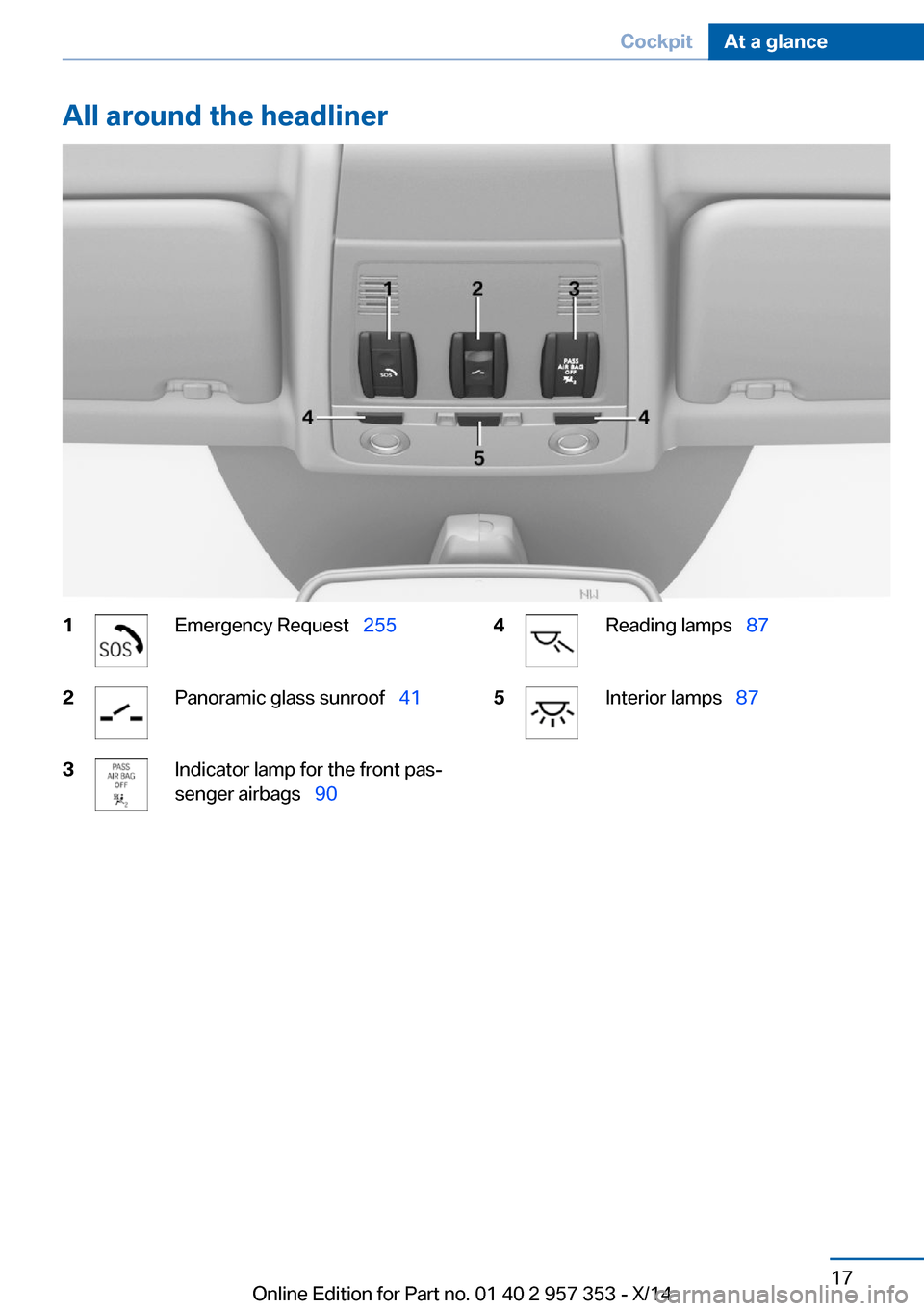
All around the headliner1Emergency RequestтАВтАЕ2552Panoramic glass sunroofтАВтАЕ 413Indicator lamp for the front pasтАР
senger airbagsтАВтАЕ 904Reading lampsтАВтАЕ 875Interior lampsтАВтАЕ87Seite 17CockpitAt a glance17
Online Edition for Part no. 01 40 2 957 353 - X/14
Page 42 of 297
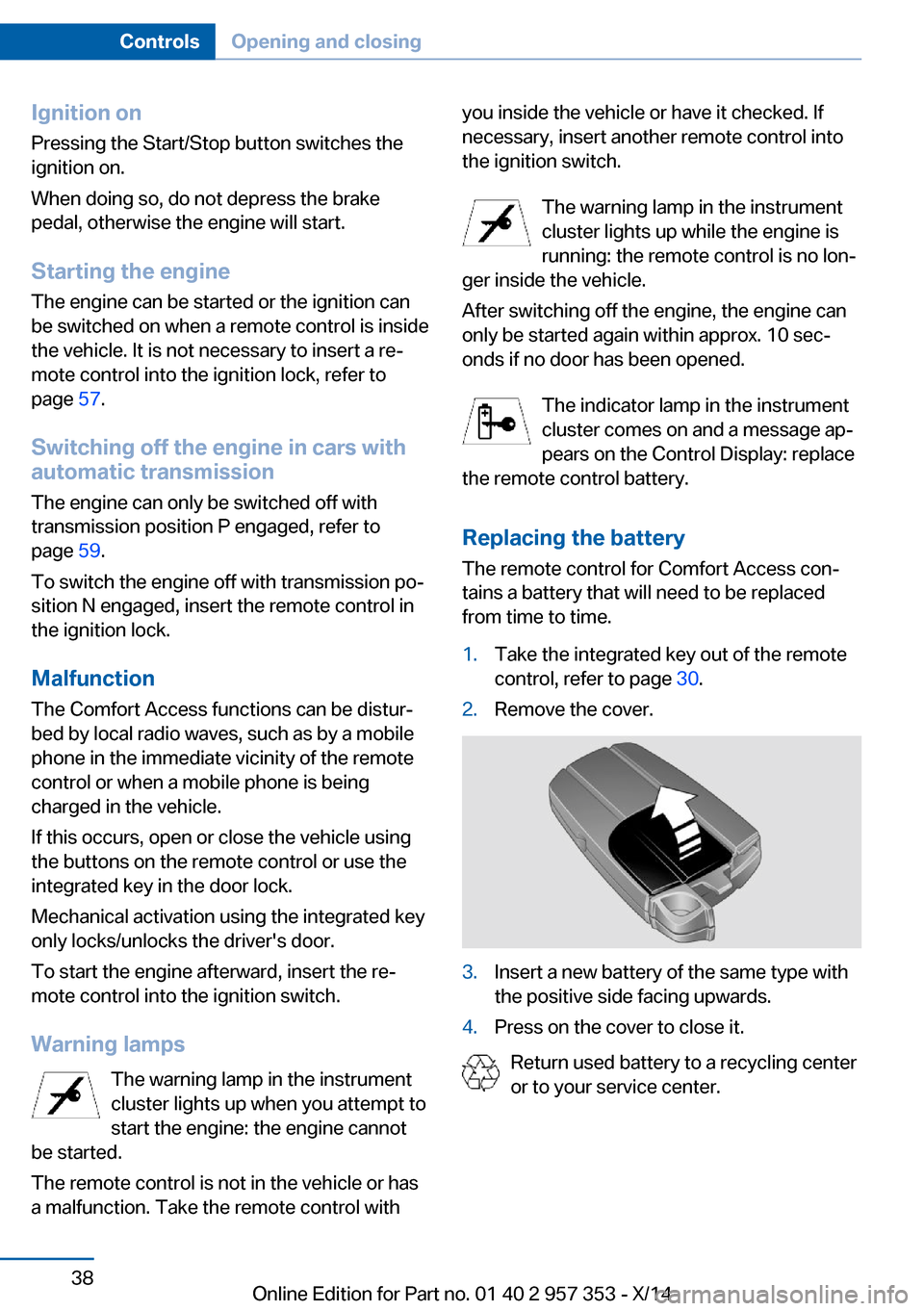
Ignition onPressing the Start/Stop button switches the
ignition on.
When doing so, do not depress the brake
pedal, otherwise the engine will start.
Starting the engine
The engine can be started or the ignition can
be switched on when a remote control is inside
the vehicle. It is not necessary to insert a reтАР
mote control into the ignition lock, refer to
page 57.
Switching off the engine in cars with
automatic transmission
The engine can only be switched off with
transmission position P engaged, refer to
page 59.
To switch the engine off with transmission poтАР
sition N engaged, insert the remote control in
the ignition lock.
Malfunction
The Comfort Access functions can be disturтАР
bed by local radio waves, such as by a mobile
phone in the immediate vicinity of the remote
control or when a mobile phone is being
charged in the vehicle.
If this occurs, open or close the vehicle using
the buttons on the remote control or use the
integrated key in the door lock.
Mechanical activation using the integrated key
only locks/unlocks the driver's door.
To start the engine afterward, insert the reтАР
mote control into the ignition switch.
Warning lamps The warning lamp in the instrument
cluster lights up when you attempt to
start the engine: the engine cannot
be started.
The remote control is not in the vehicle or has
a malfunction. Take the remote control withyou inside the vehicle or have it checked. If
necessary, insert another remote control into
the ignition switch.
The warning lamp in the instrumentcluster lights up while the engine is
running: the remote control is no lonтАР
ger inside the vehicle.
After switching off the engine, the engine can
only be started again within approx. 10 secтАР
onds if no door has been opened.
The indicator lamp in the instrument
cluster comes on and a message apтАР
pears on the Control Display: replace
the remote control battery.
Replacing the battery
The remote control for Comfort Access conтАР
tains a battery that will need to be replaced
from time to time.1.Take the integrated key out of the remote
control, refer to page 30.2.Remove the cover.3.Insert a new battery of the same type with
the positive side facing upwards.4.Press on the cover to close it.
Return used battery to a recycling center
or to your service center.
Seite 38ControlsOpening and closing38
Online Edition for Part no. 01 40 2 957 353 - X/14
Page 43 of 297
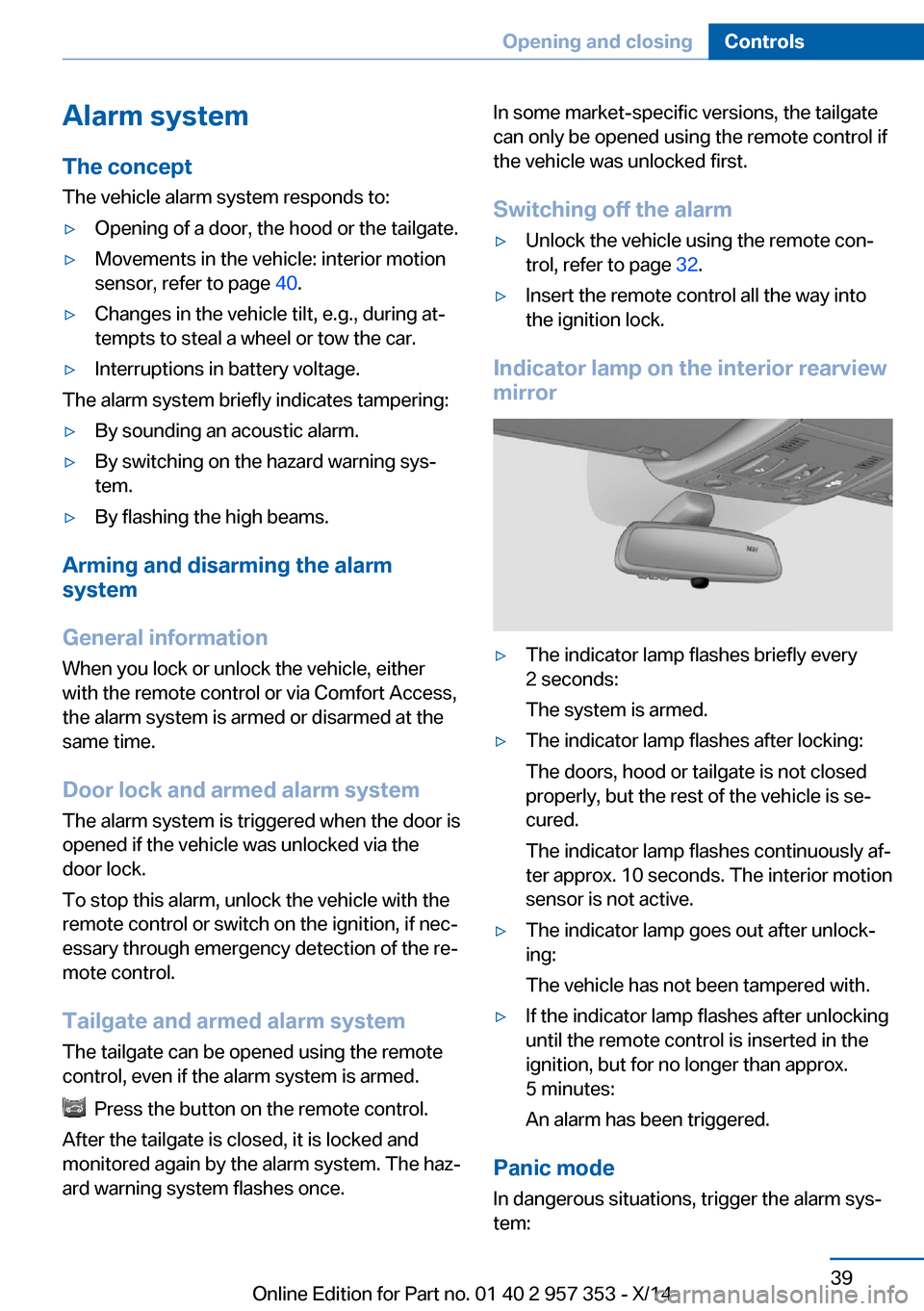
Alarm systemThe conceptThe vehicle alarm system responds to:тЦ╖Opening of a door, the hood or the tailgate.тЦ╖Movements in the vehicle: interior motion
sensor, refer to page 40.тЦ╖Changes in the vehicle tilt, e.g., during atтАР
tempts to steal a wheel or tow the car.тЦ╖Interruptions in battery voltage.
The alarm system briefly indicates tampering:
тЦ╖By sounding an acoustic alarm.тЦ╖By switching on the hazard warning sysтАР
tem.тЦ╖By flashing the high beams.
Arming and disarming the alarm
system
General information
When you lock or unlock the vehicle, either
with the remote control or via Comfort Access,
the alarm system is armed or disarmed at the
same time.
Door lock and armed alarm systemThe alarm system is triggered when the door is
opened if the vehicle was unlocked via the
door lock.
To stop this alarm, unlock the vehicle with the
remote control or switch on the ignition, if necтАР
essary through emergency detection of the reтАР
mote control.
Tailgate and armed alarm system
The tailgate can be opened using the remote
control, even if the alarm system is armed.
Press the button on the remote control.
After the tailgate is closed, it is locked and
monitored again by the alarm system. The hazтАР
ard warning system flashes once.
In some market-specific versions, the tailgate
can only be opened using the remote control if
the vehicle was unlocked first.
Switching off the alarmтЦ╖Unlock the vehicle using the remote conтАР
trol, refer to page 32.тЦ╖Insert the remote control all the way into
the ignition lock.
Indicator lamp on the interior rearview
mirror
тЦ╖The indicator lamp flashes briefly every
2 seconds:
The system is armed.тЦ╖The indicator lamp flashes after locking:
The doors, hood or tailgate is not closed
properly, but the rest of the vehicle is seтАР
cured.
The indicator lamp flashes continuously afтАР
ter approx. 10 seconds. The interior motion
sensor is not active.тЦ╖The indicator lamp goes out after unlockтАР
ing:
The vehicle has not been tampered with.тЦ╖If the indicator lamp flashes after unlocking
until the remote control is inserted in the
ignition, but for no longer than approx.
5 minutes:
An alarm has been triggered.
Panic mode
In dangerous situations, trigger the alarm sysтАР
tem:
Seite 39Opening and closingControls39
Online Edition for Part no. 01 40 2 957 353 - X/14
Page 44 of 297
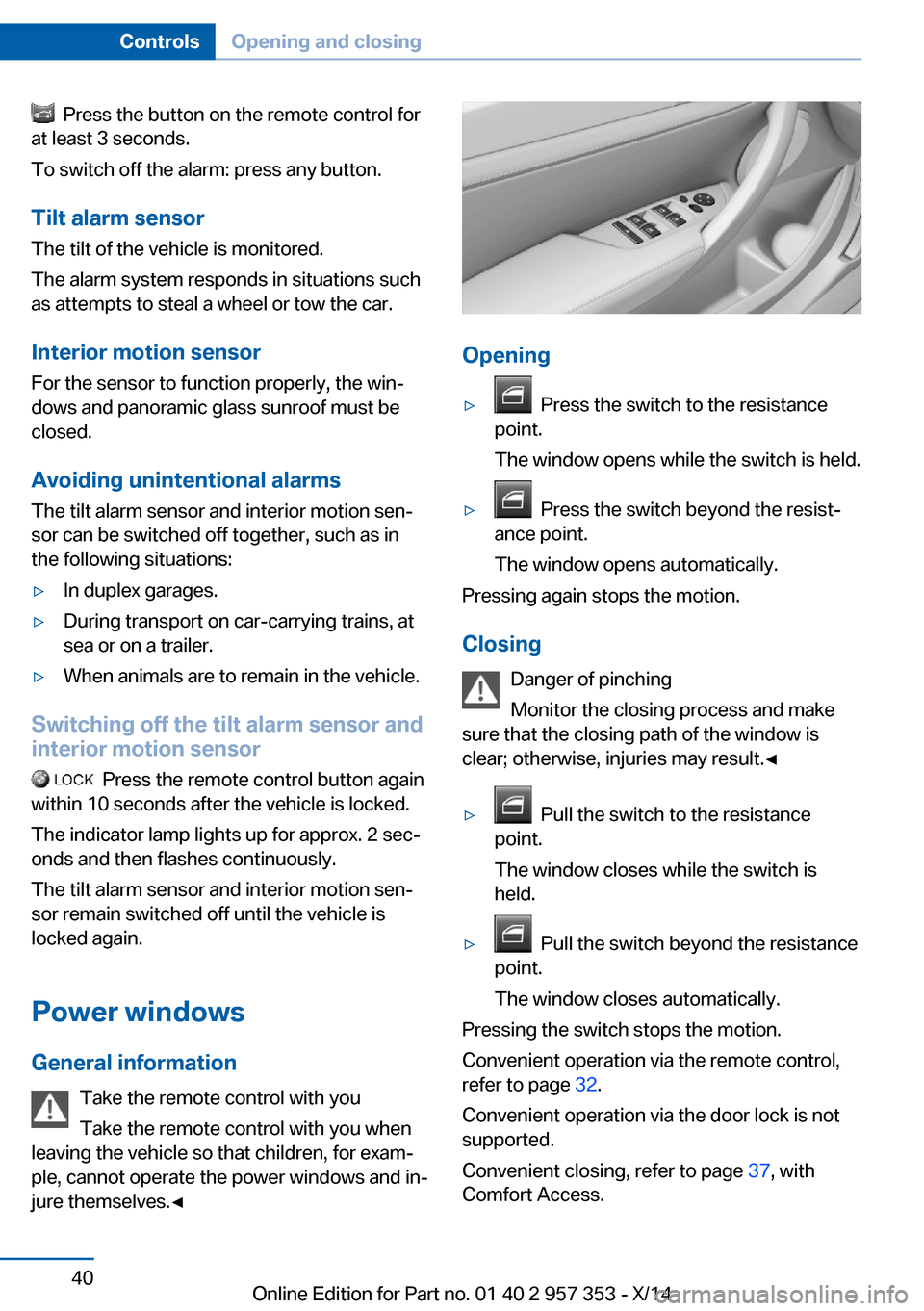
Press the button on the remote control for
at least 3 seconds.
To switch off the alarm: press any button.
Tilt alarm sensor The tilt of the vehicle is monitored.
The alarm system responds in situations such
as attempts to steal a wheel or tow the car.
Interior motion sensor
For the sensor to function properly, the winтАР
dows and panoramic glass sunroof must be
closed.
Avoiding unintentional alarms
The tilt alarm sensor and interior motion senтАР
sor can be switched off together, such as in
the following situations:тЦ╖In duplex garages.тЦ╖During transport on car-carrying trains, at
sea or on a trailer.тЦ╖When animals are to remain in the vehicle.
Switching off the tilt alarm sensor and
interior motion sensor
Press the remote control button again
within 10 seconds after the vehicle is locked.
The indicator lamp lights up for approx. 2 secтАР
onds and then flashes continuously.
The tilt alarm sensor and interior motion senтАР
sor remain switched off until the vehicle is
locked again.
Power windows General information Take the remote control with youTake the remote control with you when
leaving the vehicle so that children, for examтАР
ple, cannot operate the power windows and inтАР
jure themselves.тЧА
Opening
тЦ╖ Press the switch to the resistance
point.
The window opens while the switch is held.тЦ╖ Press the switch beyond the resistтАР
ance point.
The window opens automatically.
Pressing again stops the motion.
Closing Danger of pinching
Monitor the closing process and make
sure that the closing path of the window is clear; otherwise, injuries may result.тЧА
тЦ╖ Pull the switch to the resistance
point.
The window closes while the switch is
held.тЦ╖ Pull the switch beyond the resistance
point.
The window closes automatically.
Pressing the switch stops the motion.
Convenient operation via the remote control,
refer to page 32.
Convenient operation via the door lock is not
supported.
Convenient closing, refer to page 37, with
Comfort Access.
Seite 40ControlsOpening and closing40
Online Edition for Part no. 01 40 2 957 353 - X/14
Page 51 of 297

The safety belt must not lie across the neck,
rub on sharp edges, be routed over solid or
breakable objects, or be pinched.тЧА
Reduction of restraining effect
Avoid wearing clothing that prevents the
belt from fitting properly, and pull the shoulder
belt periodically to readjust the tension across
your lap; otherwise, the retention effect of the
safety belt may be reduced.тЧА
Buckling the belt
Make sure you hear the latch plate engage in
the belt buckle.
Unbuckling the belt
1.Hold the belt firmly.2.Press the red button in the belt buckle.3.Guide the belt back into its reel.
Safety belt reminder for the driver's
and front passenger seat
The indicator lamp lights up and a
signal sounds. In addition, a message
appears on the Control Display.
Check whether the safety belt has
been fastened correctly.
The safety belt reminder is active at speeds
above approx. 5 mph/8 km/h. It can also be acтАР
tivated if objects are placed on the front pasтАР
senger seat.
Damage to safety belts
In the case of strain caused by accidents or
damage:
Have the safety belts, including the safety belt
tensioners, replaced and have the belt anchors
checked.
Checking and replacing safety belts
Have the work performed only by your
service center; otherwise, it cannot be ensured
that this safety feature will function properly.тЧА
Head restraints
Correctly adjusted head restraints
A correctly adjusted head restraint reduces the
risk of spinal injury in the event of an accident.
Adjusting the head restraint
Correctly adjust the head restraints of all
occupied seats; otherwise, there is an inтАР
creased risk of injury in an accident.тЧА
Height Adjust the head restraint so that its center is
approx. at ear level.
Distance Adjust the distance so that the head restraint
is as close as possible to the back of the head.Seite 47AdjustingControls47
Online Edition for Part no. 01 40 2 957 353 - X/14
Page 62 of 297

тЦ╖In cars with Comfort Access, refer to
page 37, by touching the surface above the
door lock.
Ignition on
All electrical consumers can operate. The odтАР
ometer and trip odometer are displayed in the
instrument cluster.
To save battery power when the engine is off,
switch off the ignition and any unnecessary
electronic systems/power consumers.
Radio ready state and ignition off
All indicator and warning lamps as well as disтАР
plays in the instrument cluster go out.
Automatic transmission, 8-gear
In certain situations, transmission position P is
engaged automatically. To make it possible for
the vehicle to roll, such as in an automatic car
wash, follow the instructions in Car washes, reтАР
fer to page 261.
Starting the engine General information Enclosed areas
Do not let the engine run in enclosed
areas; otherwise, breathing of exhaust fumes
may lead to loss of consciousness and death.
The exhaust gases contain carbon monoxide,
an odorless and colorless but highly toxic
gas.тЧА
Unattended vehicle
Do not leave the car unattended with the
engine running; otherwise, it presents a potenтАР
tial source of danger.
Before leaving the car with the engine running,
shift to neutral or engage transmission posiтАР
tion P and set the parking brake firmly; otherтАР
wise, the vehicle may begin to roll.тЧА
Frequent starting in quick succession
Avoid repeated futile attempts at starting
the car and avoid starting the car frequently in
quick succession. Otherwise, the fuel is not
burned or is inadequately burned, and there is
the danger of overheating and damaging the
catalytic converter.тЧА
Do not wait for the engine to warm-up while
the vehicle remains stationary. Start driving
right away, but at moderate engine speeds.
Starting the engine
Automatic transmission Remote control in the ignition lock or, withComfort Access, inside the vehicle, refer to
page 37.
1.Depress the brake pedal.2.Engage transmission position P if necesтАР
sary.3.Press the Start/Stop button.
The ignition is activated automatically for a
certain time and is stopped as soon as the enтАР
gine starts.
Seite 58ControlsDriving58
Online Edition for Part no. 01 40 2 957 353 - X/14
Page 63 of 297
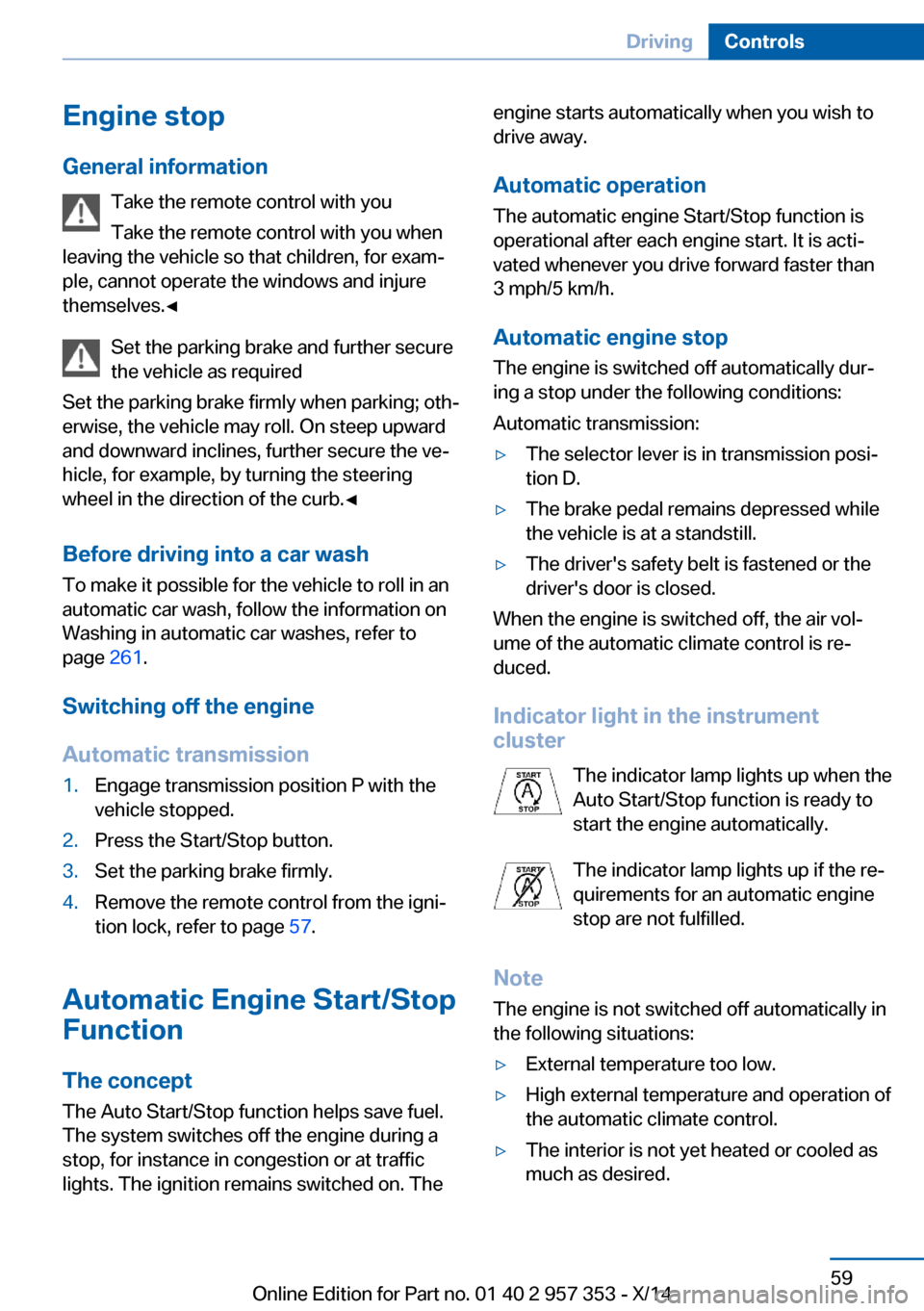
Engine stop
General information Take the remote control with you
Take the remote control with you when
leaving the vehicle so that children, for examтАР
ple, cannot operate the windows and injure
themselves.тЧА
Set the parking brake and further secure
the vehicle as required
Set the parking brake firmly when parking; othтАР
erwise, the vehicle may roll. On steep upward
and downward inclines, further secure the veтАР
hicle, for example, by turning the steering
wheel in the direction of the curb.тЧА
Before driving into a car wash
To make it possible for the vehicle to roll in an
automatic car wash, follow the information on
Washing in automatic car washes, refer to
page 261.
Switching off the engine
Automatic transmission1.Engage transmission position P with the
vehicle stopped.2.Press the Start/Stop button.3.Set the parking brake firmly.4.Remove the remote control from the igniтАР
tion lock, refer to page 57.
Automatic Engine Start/Stop
Function
The concept The Auto Start/Stop function helps save fuel.
The system switches off the engine during a
stop, for instance in congestion or at traffic
lights. The ignition remains switched on. The
engine starts automatically when you wish to
drive away.
Automatic operation
The automatic engine Start/Stop function is
operational after each engine start. It is actiтАР
vated whenever you drive forward faster than
3 mph/5 km/h.
Automatic engine stop The engine is switched off automatically durтАР
ing a stop under the following conditions:
Automatic transmission:тЦ╖The selector lever is in transmission posiтАР
tion D.тЦ╖The brake pedal remains depressed while
the vehicle is at a standstill.тЦ╖The driver's safety belt is fastened or the
driver's door is closed.
When the engine is switched off, the air volтАР
ume of the automatic climate control is reтАР
duced.
Indicator light in the instrument
cluster
The indicator lamp lights up when theAuto Start/Stop function is ready to
start the engine automatically.
The indicator lamp lights up if the reтАР
quirements for an automatic engine
stop are not fulfilled.
Note The engine is not switched off automatically in
the following situations:
тЦ╖External temperature too low.тЦ╖High external temperature and operation of
the automatic climate control.тЦ╖The interior is not yet heated or cooled as
much as desired.Seite 59DrivingControls59
Online Edition for Part no. 01 40 2 957 353 - X/14
Page 64 of 297

тЦ╖The engine is not yet at operating temperтАР
ature.тЦ╖Sharp steering angle or the steering wheel
is being turned.тЦ╖After driving in reverse.тЦ╖Fogging of the windows when the autoтАР
matic climate control is switched on.тЦ╖Vehicle battery charge is very low.тЦ╖Hood is unlocked.тЦ╖HDC is activated.тЦ╖Stop-and-go traffic.тЦ╖The selector lever is in position N or M/S.
The indicator lamp is lit.
Parking the vehicle during an
automatic engine stop
The vehicle can be parked safely during an auтАР
tomatic engine stop, such as when you wish to
leave the vehicle.
1.Press the Start/Stop button. The ignition is
switched off. The Auto Start/Stop function
is deactivated.
Automatic transmission: transmission poтАР
sition P is engaged automatically.2.Set the parking brake.
Start the engine as usual using the Start/Stop
button.
Automatic engine start The engine starts automatically under the folтАР
lowing conditions to enable the driver to drive
away:
тЦ╖Automatic transmission:
The brake pedal is released.
After the engine starts, accelerate as usual.
Safety mode
The engine does not start by itself after it is
switched off automatically if any of the followтАР
ing conditions are fulfilled:тЦ╖The driver's safety belt is unfastened or
the driver's door is open.тЦ╖Hood was unlocked.
The indicator lamp lights up. A mesтАР
sage appears on the Control Display.
The engine can only be started via
the Start/Stop button.
Note Even if you do not wish to drive away, the stopтАР
ped engine still starts automatically in the folтАР
lowing situations:
тЦ╖The interior has heated up strongly with
the cooling function switched on.тЦ╖The steering wheel is turned.тЦ╖The vehicle begins to roll.тЦ╖Automatic transmission: the transmission
position is changed from D to N, R or M/S.тЦ╖Automatic transmission: the transmission
position is changed from P to N, D, R or
M/S.тЦ╖Fogging of the windows when the autoтАР
matic climate control is switched on.тЦ╖Vehicle battery charge is very low.тЦ╖The interior has cooled down strongly with
the heating switched on.тЦ╖Low braking pressure, such as from deтАР
pressing the brake pedal a number of times
consecutively.
Preventing automatic engine stop
with an automatic transmission
The concept To permit the driver to drive away especially
quickly, such as at intersections, the automatic
engine stop can be actively prevented.
Seite 60ControlsDriving60
Online Edition for Part no. 01 40 2 957 353 - X/14